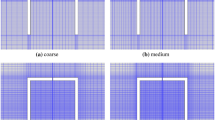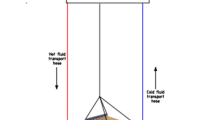Abstract
The state-of-the-art OpenFOAM technology is used to develop a numerical model that can be devoted to numerically investigating wake-collapse internal waves generated by a submerged moving body. The model incorporates body geometry, propeller forcing, and stratification magnitude of seawater. The generation mechanism and wave properties are discussed based on model results. It was found that the generation of the wave and its properties depend greatly on the body speed. Only when that speed exceeds some critical value, between 1.5 and 4.5 m/s, can the moving body generate wake-collapse internal waves, and with increases of this speed, the time of generation advances and wave amplitude increases. The generated wake-collapse internal waves are confirmed to have characteristics of the second baroclinic mode. As the body speed increases, wave amplitude and length increase and its waveform tends to take on a regular sinusoidal shape. For three linearly temperature-stratified profiles examined, the weaker the stratification, the stronger the wake-collapse internal wave.
Similar content being viewed by others
References
Afanasyev Y D, Peltier W R. 2001. On breaking internal waves over the sill in Knight Inlet. Proceedings of the Royal Society A: Mathematical, Physical and Engineering Sciences, 457(2016): 2799–2825, http://dx.dor.org/10.1098/rspa.2000.0735.
Alin N, Bensow R E, Fureby C, Huuva T, Svennberg U. 2010. Current capabilities of DES and LES for submarines at straight course. Journal of Ship Research, 54(3): 184–196.
Bonneton P, Chomaz J M, Hopfinger E J. 1993. Internal waves produced by the turbulent wake of a sphere moving horizontally in a stratified fluid. Journal of Fluid Mechanics, 254: 23–40.
Brandt A, Rottier J R. 2015. The internal wavefield generated by a towed sphere at low Froude number. Journal of Fluid Mechanics, 769: 103–129, http://dx.doi.org/10.1017/jfm.2015.96.
Chase N, Carrica P M. 2013. Submarine propeller computations and application to self-propulsion of DARPA Suboff. Ocean Engineering, 60: 68–80, http://dx.doi.org/10.1016/j.oceaneng.2012.12.029.
Chen Z W, Xie J S, Wang D X, Zhan J M, Xu J X, Cai S Q. 2014. Density stratification influences on generation of different modes internal solitary waves. Journal of Geophysical Research: Oceans, 119(10): 7029–7046, http://dx.doi.org/10.1002/2014jc010069.
Chernykh G G, Moshkin N P, Voropayeva O F. 2004. Internal waves generated by turbulent wakes behind towed and self-propelled bodies in a stably stratified medium. Russian Journal of Numerical Analysis and Mathematical Modelling, 19(1): 1–16, http://dx.doi.org/10.1515/156939804322802567.
Flores F, Garreaud R, Muñoz R C. 2013. CFD simulations of turbulent buoyant atmospheric flows over complex geometry: solver development in OpenFOAM. Computers & Fluids, 82: 1–13, http://dx.doi.org/10.1016/j.compfluid.2013.04.029.
Fringer O B, Gerritsen M, Street R L. 2006. An unstructuredgrid, finite-volume, nonhydrostatic, parallel coastal ocean simulator. Ocean Modelling, 14(3–4): 139–173, http://dx.doi.org/10.1016/j.ocemod.2006.03.006.
Gilreath H E, Brandt A. 1985. Experiments on the generation of internal waves in a stratified fluid. AIAA Journal, 23(5): 693–700, http://dx.doi.org/10.2514/3.8972.
Guan H, Wei G, Du H. 2012. Hydrodynamic properties of interactions of three-dimensional internal solitary waves with submarine. Journal of PLA University of Science and Technology (Natural Science Edition), 13(5): 277–582. (in Chinese with English abstract)
Houcine H, Chashechkin Y D, Fraunié P, Fernando H J S, Gharbi A, Lili T. 2012. Numerical modeling of the generation of internal waves by uniform stratified flow over a thin vertical barrier. International Journal for Numerical Methods in Fluids, 68(4): 451–466, http://dx.doi.org/10.1002/fld.2513.
Kao T W, Pao H P. 1980. Wake collapse in the thermocline and internal solitary waves. Journal of Fluid Mechanics, 97(1): 115–127, http://dx.doi.org/10.1017/S0022112080002455.
Legg S, Adcroft A. 2003. Internal wave breaking at concave and convex continental slopes. Journal of Physical Oceanography, 33(11): 2224–2246, http://dx.doi.org/10.1175/1520-0485(2003)033<2224:IWBACA>2.0.CO;2.
Lin J T, Pao Y H. 1979. Wakes in stratified fluids. Annual Review of Fluid Mechanics, 11: 317–338.
Lin Z H, Song J B. 2012. Numerical studies of internal solitary wave generation and evolution by gravity collapse. Journal of Hydrodynamics, Ser. B, 24(4): 541–553, http://dx.doi.org/10.1016/S1001-6058(11)60276-X.
Millero F J, Poisson A. 1981. International one-atmosphere equation of state of seawater. Oceanographic Resea rch Papers, 28(6): 625–629, http://dx.doi.org/10.1016/0198-0149(81)90122-9.
Paterson E G, Wilson R V, Stern F. 2003. General-Purpose Parallel Unsteady RANS Ship Hydrodynamics Code: CFDSHIP-IOWA. Iowa Institute of Hydraulic Research Technical Report, No. 432, University of Iowa, Iowa City.
Phillips A B, Turnock S R, Furlong M. 2009. Evaluation of manoeuvring coefficients of a self-propelled ship using a blade element momentum propeller model coupled to a Reynolds averaged Navier Stokes flow solver. Ocean Engineering, 36(15–16): 1217–1225, http://dx.doi.org/10.1016/j.oceaneng.2009.07.019.
Rojanaratanangkule W, Thomas T G, Coleman G N. 2012. Numerical study of turbulent manoeuvring-body wakes: interaction with a non-deformable free surface. Journal of Turbulence, 13: N17, http://dx.doi.org/10.1080/14685248.2012.680550.
Schetz J A, Favin S. 1979. Numerical solution of a bodypropeller combination flow including swirl and comparisons with data. Journal of Hydronautics, 13(2): 46–51, http://dx.doi.org/10.2514/3.48166.
Schooley A H, Stewart R W. 1963. Experiments with a selfpropelled body submerged in a fluid with a vertical density gradient. Journal of Fluid Mechanics, 15(1): 83–96, http://dx.doi.org/10.1017/S0022112063000070.
Stern F, Kim H T, Patel V C, Chen H C. 1988. A viscous-flow approach to the computation of propeller-hull interaction. Journal of Ship Research, 32(4): 246–262.
Stringer R M, Zang J, Hillis A J. 2014. Unsteady RANS computations of flow around a circular cylinder for a wide range of Reynolds numbers. Ocean Engineering, 87: 1–9, http://dx.doi.org/10.1016/j.oceaneng.2014.04.017.
Vlasenko V, Hutter K. 2002. Numerical experiments on the breaking of solitary internal waves over a slope-shelf topography. Journal of Physical Oceanography, 32(6): 1779–1793.
Vlasenko V, Stashchuk N, Hutter K. 2005. Baroclinic Tides: Theoretical Modeling and Observational Evidence. Cambridge University Press, Cambridge, New York. 373p.
Vlasenko V, Stashchuk N. 2007. Three-dimensional shoaling of large-amplitude internal waves. Journal of Geophysical Research: Oceans, 112(C11): C11018, http://dx.doi.org/10.1029/2007jc004107.
Wei G, Zhao X Q, Su X B, You Y X. 2009. Experimental study on time series structures of the wake in a linearly stratified fluid. Scientia Sinica: Physica, Mechanica & Astronomica, 39(9): 1338–1347. (in Chinese with English abstract)
Yang Q, Wang G D, Zhang Z G, Feng D K, Wang X Z. 2013. Numerical simulation of the submarine self-propulsion model based on CFD technology. Chinese Journal of Ship Research, 8(2): 22–27. (in Chinese with English abstract)
Yang Y J, Fang Y C, Tang T Y, Ramp S R. 2010. Convex and concave types of second baroclinic mode internal solitary waves. Nonlinear Processes in Geophys ics, 17(6): 605–614, http://dx.doi.org/10.5194/npg-17-605-2010.
Acknowledgment
The work was carried out at the National Supercomputer Center in Tianjin, and calculations were performed on supercomputer TianHe-1(A).
Author information
Authors and Affiliations
Corresponding author
Additional information
Supported by the State Key Program of National Natural Science of China (No. 60638020)
Rights and permissions
About this article
Cite this article
Liang, J., Du, T., Huang, W. et al. Numerical investigation of wake-collapse internal waves generated by a submerged moving body. Chin. J. Ocean. Limnol. 35, 967–977 (2017). https://doi.org/10.1007/s00343-017-6041-5
Received:
Accepted:
Published:
Issue Date:
DOI: https://doi.org/10.1007/s00343-017-6041-5




